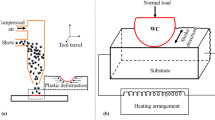Abstract
The grinding characteristics and the wear behavior of diamond wheel for grinding the optical connector ferrule were investigated by finite element analysis (FEA) and wear test. FEA of contact between diamond wheel and ferrule shows that the subsurface damage area of ferrule is 13μm from the interface of abrasive particle and matrix. Fallout of abrasive particle is affected by the stress state at the interface. A 2-D finite element model was established to calculate the distribution of stress at the interface. As the result of FEA, fallout condition of abrasive was concerned with the ratio of the critical protrusion; the ratio of particle size is about 0.6. FE model was established to investigate the effects of the diamond concentration of wheel. The FEA result shows that the lower concentration of it has larger wear volume due to the small stress propagation. To investigate grinding performance, the pin-on-disc wear test was carried out for three types of concentrations 75%, 100% and 125%. Through the wear test, it was confirmed that the 75% wheel concentration has the highest amount of wear volume. This result shows good agreement with that of FEA. And 100% concentration by considering the grinding ratio of the wheel shows the best optimized result for the grinding performance.
Similar content being viewed by others
References
Peter Blake, Thomas Bifano, Thomas Dow, Ronald O Scattergood, Precision Machining of Ceramic Materials, American Ceramic Society Bulletin 67(6) (1988)1038–1041.
S. Malkin and J. E. Ritter, Grinding Mechanisms and Strength Degradation for Ceramics, Journal of Engineering for Industry, (1989) 167–174.
S. Malkin, Grinding Technology — Theory and Applications of Machining with Abrasives, Ch. I, Ellis Horwood, Chichester, (1989) 9–17.
J. L. Mertzger, Super abrasive Grinding, Ch. 1, Butterworth, Oxford, (1986) 3–11.
Y. Zhou, P. D. Funkenbusch and D. J. Quesnel, Stress Distribution at the Abrasives-matrix Interface during Tool Wear in Bound Abrasive Grinding-Finite Element Analysis, Wear 209 (1997) 247–254.
Bi. Zhang, Howes and D. Trevor, Material-removal mechanisms in grinding ceramics, CIRP Annals — Manufacturing Technology 43(1) (1994) 305–308.
S. Malkin and T. W. Hwang, Grinding Mechanisms for Ceramics, Ann. CIRP, 45(2) (1996) 569–580.
T. W. Hwang, C. J. Evans and S. Malkin, Size effect for specific energy in grinding of silicon nitride, Wear 225–229 (PART II) (1999) 862–867.
T. W. Hwang, C. J. Evans, E. P. Whitenton and S. Malkin, High speed grinding of silicon nitride with electroplated diamond wheels, part 1: Wear and wheel life, Journal of Manufacturing Science and Engineering, Transactions of the ASME 122(1) (2000) 32–41.
T. W. Hwang, C. J. Evans and S. Malkin, High Speed Grinding of Silicon Nitride With Electroplated Diamond Wheels, Part 2: Wheel Topography and Grinding Mechanisms, Journal of Manufacturing Science and Engineering, Transactions of the ASME 122(1) (2000) 42–50.
S. Malkin and N. Joseph, Minimum Energy in Abrasive Processes, Wear 32(1), (1975) 15–23.
T. W. Hwang and S. Malkin, Upper bound analysis for specific energy in grinding of ceramics, Wear 231(2) (1999) 161–171.
S. Malkin, Correlation between Solid Particle Erosion of Metals and Their Melting Energies, Wear 68(3) (1981) 391–396.
G. N. Shah, A. C. Bell and S. Malkin, Quantitative Characterization of Abrasive Surfaces Using a New Profile Measuring System, Wear 41(2) (1977) 315–325.
C. Chen, Y. Jung and I. Inasaki, Surface, Cylindrical and Internal Grinding of Advanced Ceramics, Grinding Fundamentals and Applications, PED-Vol. 39, ASME (1989) 201–211.
T. W. Hwang and S. Malkin, Grinding Mechanisms and Energy Balance for Ceramics, ASME J. Manuf. Sci. Eng., 121, (1999) 623–631.
D. Miller and A. Ball, The wear of diamonds in impregnated diamond bit drilling, Wear 141 (1991) 311–320.
Y. S. Uao and S. Y. Luo, Wear characteristics of sintered diamond composite during circular swing, Wear 157 (1992) 325–337.
X. Tian and S. Tian, The wear mechanisms of impregnated diamond bits, Wear 177 (1994) 81–91.
W. Konig and A. Neises, Wear mechanisms of ultrahard, non-metallic cutting materials, Wear 162/164 (1993) 12–21.
M. C. Shaw, New Theory of Grinding, Inst Eng Aust. Mech. Chem. Eng Trans MC8(1) (1972) 73–78.
Author information
Authors and Affiliations
Corresponding author
Additional information
This paper was recommended for publication in revised form by Associate Editor Maenghyo Cho
Chang-Min Suh received his B.S. and M.S. degrees in mechanical engineering from Busan Na-tional University in 1964 and 1968, respectively, and received his Ph.D. degree from the University of Tokyo in 1981. He now is a professor at Kyungpook National University. He has served as the Head of the Department of Mechanical Engineering at Kyungpook National University, a Visiting Professor of Materials Science and Engineering in Univ. of California Berkeley, a Head of the Institute of Engineering Design Technology Kyungpook Nat’l Univ, and a Head of the Technology Innovation Center designated by the Department of Commerce and Industry of Korea.
Rights and permissions
About this article
Cite this article
Suh, CM., Bae, KS. & Suh, MS. Wear behavior of diamond wheel for grinding optical connector ferrule — FEA and wear test —. J Mech Sci Technol 22, 2009–2015 (2008). https://doi.org/10.1007/s12206-008-0407-8
Received:
Revised:
Accepted:
Published:
Issue Date:
DOI: https://doi.org/10.1007/s12206-008-0407-8




